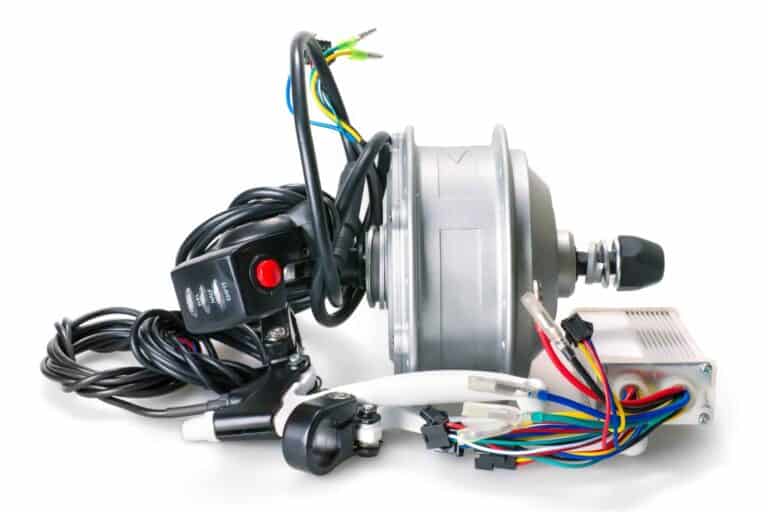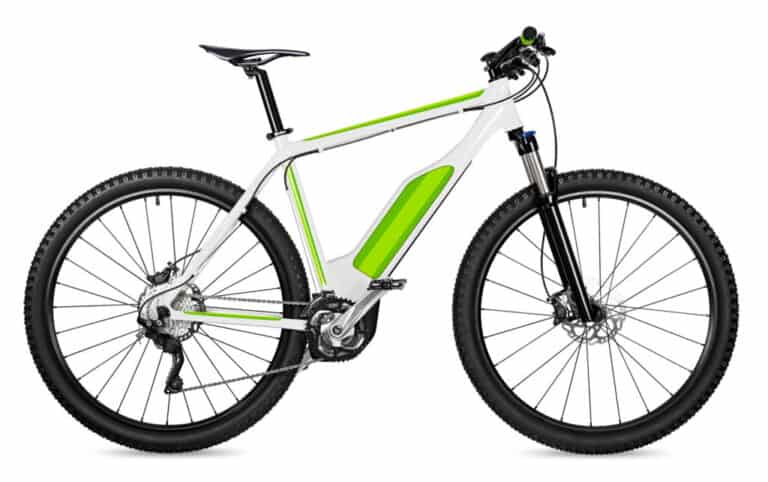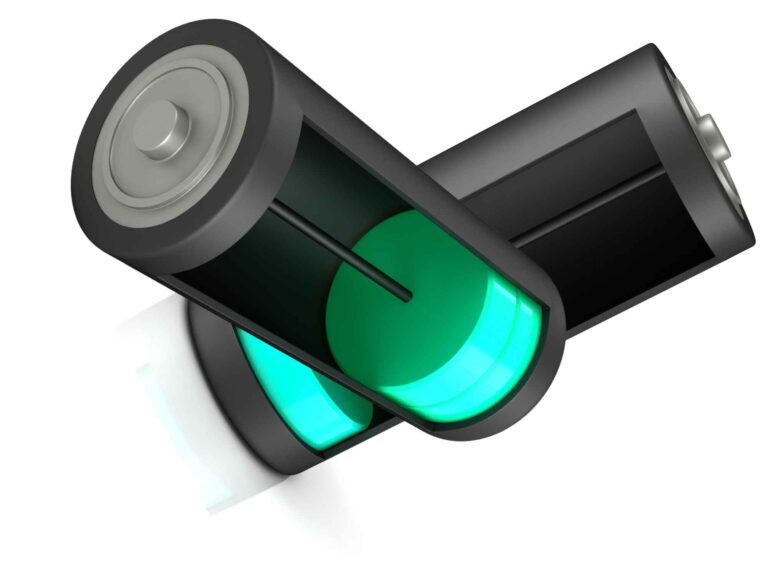How Much Does it Cost to Charge an eBike (It May Shock You)
When I had my first electric bike, I was worried about the charging cost. However, I later discovered that the charging cost was affordable. So how much does it cost to charge an eBike?
As a whole, charging your electric bike will cost $5-$28 a month. However, the charging cost depends on several factors, including the battery capacity, charging time, and electricity rate in your area.
Since electric bikes need batteries for its motor to function, you need to know how much it costs to charge your electric bike battery. In this post, we will tackle how to compute your e-bike’s charging cost, how to charge your electric bike battery, and some practical safety tips you can use when charging your electric bike battery.
How Much Does It Cost to Charge an eBike
When determining the charging cost of an electric bike, one must consider the electric bike’s watt-hour capacity, the battery’s charging time, and the electricity rate per kilowatt-hour in your area. Electric bike batteries have capacities ranging from 300Wh to 1000Wh, and the charging time of electric bike batteries is about four to six hours.
Furthermore, the electricity rate depends on your state, which may change every month. As per ChooseEnergy, the average electricity rate in the United States in February 2023 was $0.1546 per kilowatt-hour. You should check out ChooseEnergy’s website to find the exact electricity rate in your particular area.
Your e-bike’s total monthly charging cost may also depend on how frequently you charge your electric bike. For instance, if you use your electric bike every day and charge the battery once a day, you may have an average charging cost of $5-$28 a month.
How to Compute an eBike’s Charging Cost
As a whole, you can determine the charging cost of your electric bike by using the equation “Cost of Charging e-bike= [(Voltage X Ah)/1000] X (rate of charge per KWh) X (hours of charge).”
The following details are needed before calculating your eBike’s Charging Cost.:
- eBike’s battery watt-hour capacity
- Electricity rate per kWh in your state
- Charging time
The watt-hour capacity of your electric bike’s battery is often found in your e-bike’s manual. If there is no watt-hour capacity stated, you can calculate it by multiplying the voltage and amp-hour of your battery. For instance, if your electric bike uses a 48V 13 Ah battery with a charging time of four hours, we can calculate the watt-hour capacity as follows:
48V X 13Ah = 624 watt-hour
As far as electricity rates are concerned, one state may differ from another. However, for October 2022, the average electricity rate in the United States was $0.1546. You may check your state’s electricity rate on the ChooseEnergy website.
To proceed with the computation of charging cost, we are going to use the equation below.
Cost of Charging e-bike= [(Voltage X Ah)/1000] X (rate of charge per KWh) X (hours of charge)
We now have
Cost of Charging e-bike= [624Wh/1000] X (0.1546) X (4) = $0.39
Therefore, an electric bike with a 48V 13Ah battery with four hours of charging time has a potential charging cost of $0.39 for a single charge.
As a result, if you use your electric bike every day and charge it once a day, you will likely have a monthly charging cost of $11.70. In contrast, if you rarely use your electric bike, the charging cost would be less than $11.70.
We have created a table below showing the possible charging cost per charge of several electric bikes.
Electric Bike | Cost of Purchase | Battery Capacity | Electricity Rate | Charging Time | Charging Cost |
| EngineLab NGN E450 Electric Commuter Bike | $1,799 | 672 Wh | $ 0.1546 | 4 hours | $0.42 for a single charge |
| EngineLab NGN E450 ST Electric Commuter Bike | $1,799 | 672 Wh | $ 0.1546 | 4 hours | $0.42 for a single charge |
| Lectric XP Premium Electric Bike | $1,599 | 499.2 Wh | $ 0.1546 | 4-6 hours | $0.31-$0.46 for a single charge |
| Lectric XP Step-Thru 2.0 Long-Range Electric Bike | $1,049 | 672 Wh | $ 0.1546 | 4-6 hours | $0.42-$0.62 for a single charge |
| Ride1Up 700-Series XR Electric Bike | $1,595 | 720 Wh | $ 0.1546 | 2-6 hours | $0.22-$0.67 for a single charge |
| Ride1Up Core-5 Electric Bike | $1,195 | 614.4 Wh | $ 0.1546 | 2-6 hours | $0.19-$0.57 for a single charge |
| Wing Freedom 2 Electric Bike | With standard battery (8.8Ah): $1,048.98With 10.4Ah battery: $1,148.98With 14 Ah battery: $1,248.98 | 316.8 Wh; 374.4 Wh; 504 Wh | $ 0.1546 | 4 hours | $0.20-$0.31 for a single charge |
| Wing Freedom X Electric Bike | With standard battery (8.8Ah): $1,148.98 With 10.4Ah battery: $1,248.98With 14 Ah battery: $1,348.98 | 316.8 Wh; 374.4 Wh; 504 Wh | $ 0.1546 | 4 hours | $0.20-$0.31 for a single charge |
| Aventon Level 2 Commuter Electric Bike | $1,949 | 672 Wh | $ 0.1546 | 4-5 hours | $0.42-$0.52 for a single charge |
| Aventon Aventure Electric Bike | $1,899 | 720 Wh | $ 0.1546 | 4-5 hours | $0.45-$0.56 for a single charge |
| RadPower RadRunner Plus Electric Bike | $1,899 | 672 Wh | $ 0.1546 | 3.5-7 hours | $0.36-$0.73 for a single charge |
| RadPower RadWagon 4 Electric Bike | $1,999 | 672 WH | $ 0.1546 | 3-7 hours | $0.31-$0.73 for a single charge |
| Zugo Rhino Fat Tire Electric Bike | With standard battery (750 Wh): $1,999With 1000 Wh (1Kwh) battery: $2,499 | 750 Wh 1000 Wh (1Kwh): | $ 0.1546 | 6-8 hours | $0.70-$1.24 for a single charge |
| Zugo Rhino Step Through Electric Bike | With standard battery (750 Wh): $1,999With 1000 Wh (1Kwh) battery: $2,499 | 750 Wh 1000 Wh (1Kwh) | $ 0.1546 | 6-8 hours | $0.70-$1.24 for a single charge |
How Much Electricity is Used to Charge an Electric Bike?
As a general rule, the amount of electricity needed to charge an electric bike depends primarily on its capacity. Generally, electric bikes use 300-1000 watt-hour batteries. Therefore, charging an electric bike may also take 300-1000 watt-hours.
Are eBikes Expensive to Charge?
On average, eBikes are not expensive to charge. Different electric bikes may have different charging costs. In most cases, a single charge of your electric bike battery will only cost anywhere from just a few cents to around $2.00.
As mentioned earlier, the charging cost of electric bikes depends on the electric bike’s watt-hour capacity, the battery’s charging time and the electricity rate per kilowatt-hour. As a result, if any of these variables are high, your charging cost would be more expensive. In addition, the total charging cost of your e-bike over a year will also be affected by how frequently you use and charge your electric bike.
How to Charge an Electric Bike Battery?
As a whole, you can charge your electric bike battery by plugging a cord from the electric bike into an electric outlet. If the battery is removable, you can remove it and then plug a cord from the battery into an electric outlet. Each electric bike has its own charger.
Electric bikes can be charged at home or in some public places, such as bike shops and rest stops. In the United States, most electric bikes plug into a 110V outlet. However, you can also charge your electric bike in an EV outlet if your electric bike is compatible with higher voltages since most EV outlets use 220V. You can also choose to charge your electric bike on the go. Check out our article “Charging eBike on the Go (Car Battery, Inverter, Power Bank, Solar)” for more details.
Just remember, when charging an electric bike battery, always follow practical safety precautions to avoid possible risks.
If you need clarification on any of the steps of charging an electric bike battery, you can watch the video below.
Safety Tips for Charging Electric Bike Battery
- Read and follow your e-bike’s manual.
- Use a compatible charger to charge your electric bike battery.
- Do not charge your e-bike battery at temperatures lower or higher than the standard charging temperatures found in your e-bike’s manual.
- Keep metal objects away from your electric bike battery.
- Do not charge your e-bike battery near flammable materials.
- Do not overcharge your battery.
Read and Follow Your eBike Manual
Your eBike’s manual contains all the pertinent information about your electric bike and how to appropriately maintain it. This includes instructions on charging and discharging your electric bike battery. Different electric bikes have different user guides, so it is a must to read your e-bike’s manual thoroughly and follow it at all times.
Use a Compatible Charger When Charging Your Electric Bike Battery
A charger is included when you purchase an electric bike. It is highly recommended to use the provided charger to maintain your battery’s health.
Using a charger that was not specifically made for your battery can cause damage to it. Oftentimes this happens when the charger puts out a higher current than your battery was designed to accept.
If your charger gets damaged, we recommend contacting the store where you bought your electric bike to ask if they sell a compatible charger. You can also contact your electric bike’s manufacturer directly for a replacement.
Do Not Charge Your eBike Battery Outside Standard Charging Temperatures
If the temperature is too hot or too cold, it can significantly affect the performance and efficiency of your electric bike battery. Charging your battery at low or high temperatures increases the risk of damaging your battery permanently. It can even cause a fire. Most times, the ideal charging temperatures of an electric bike battery are between 1°F to 113°F (5°C to 45°C). Therefore, always be mindful of charging your electric bike battery at the “right” temperature.
Keep Metal Objects Away from Your Electric Bike Battery
Please note that metal objects are perfect conductors of electricity. So, when you charge your electric bike battery near metallic objects, there’s a chance that a short circuit may occur. This can result in your battery exploding or catching fire.
Do Not Charge Your eBike Battery Near Flammable Materials
When your electric bike battery is exposed to flammable materials, your battery could explode or start a fire.
Do Not Overcharge Your Battery
It is possible to overcharge your battery. This can cause overheating, which could potentially lead to a fire or an explosion.
Furthermore, overcharging your electric bike shortens your battery’s lifespan, efficiency, and performance. However, some chargers automatically cut off the power supply when your battery percentage reaches 100%. If your electric bike battery has an auto shut-off feature, charging your electric bike battery overnight is fine.
It would be best to follow the above-mentioned tips to continuously maintain your electric bike battery near its full capacity. If you observe any battery problems, we recommend contacting the manufacturer immediately or contacting a professional. If you want to learn more about potential electric bike battery problems you may encounter and how to fix them, read our article “E-bike Battery Problems (A Fix That Actually Works).”
A battery’s health will not last forever. Despite your best attempts to maintain it, it will likely wear out over time. If you are interested in buying an electric bike battery as a replacement, check out our article “Electric Bike Battery Cost (A Helpful Chart).”
“Whatever you do, do it safely.”
-Electric Ride Owner
Can You Leave an eBike Plugged In?
As a whole, you should not leave your electric bike plugged in. Doing so may overcharge your electric bike. Overcharging is one of the primary causes of deterioration of your battery’s health, efficiency, and lifespan.
It is advisable to always unplug your charger when your electric bike is fully charged. Aside from the above-mentioned disadvantages, overcharging can cause your battery to heat up, which can cause a fire or an explosion.
Therefore, to avoid damaging your electric bike or hurting yourself, it is always best to practice safe charging. Following the safety charging tips mentioned above will keep you and your e-bike out of harm’s way. Please note that there is nothing more important than your safety.
How Many Hours Should I Charge My eBike?
As a whole, for the first use, it is recommended that you charge your electric bike battery for twelve hours. This ensures that your electric bike battery will be completely charged.
If your electric bike battery is new, it is highly recommended that you charge it for 12 hours to ensure current flows throughout all of the battery cells. However, for the second charge, the charging time depends on your battery percentage. Generally, a fully-depleted electric bike battery will take three to seven hours to charge completely. However, charging your electric bike battery to 100% every day is not advisable. Instead, we recommend charging your battery up to 85%. You can charge your battery up to 100% once in a while.
When to Charge Your eBike Battery?
As a general rule, it is advisable to charge your electric bike battery when the battery percentage has dropped to 30%. You should not completely drain your electric bike battery because doing so may deteriorate your battery’s efficiency and lifespan.
Complete discharge of the battery should only be done occasionally, about once every 30 to 40 charges. When charging and discharging an electric bike battery, it is always best to follow the 80/20 rule. This is a rule that states that you must charge your battery up to 80% and not let it drop below 20%. That way, you will be able to maintain your battery’s efficiency. Also, setting an alarm to keep track of your charging time could also help you avoid overcharging your electric bike battery.
Should I Charge My eBike After Every Ride?
On average, you can charge your electric bike after every ride. This ensures that your battery will be ready for your next ride. Keep in mind that it is still best to charge your battery when its percentage reaches 30%.
An electric bike battery is needed for your electric motor to work. When your battery is drained, you have no other option but to ride your e-bike like a traditional bicycle without assistance.
Many owners charge their electric bikes every day or after each ride. However, if you only travel short distances and there’s a high percentage of power left in your battery, we would advise against charging your battery until the percentage drops to 30%. Doing so will keep your battery in good health.
How Far Can an Electric Bike Go on a Full Charge?
As a general rule, you can go more than 20 miles (32 km) on a fully-charged electric bike, depending on your battery capacity. Your range may be significantly affected by several factors, including weight, weather conditions, terrain type, riding style, the motor used, and pedal-assist level.
Every electric bike can achieve a different range, even those with the same watt-hour capacity. That is because of various external factors affecting the range.
Here is a list of electric bikes with their respective battery capacity and range.
| Electric Bike | Cost of Purchase | Battery Capacity | Range |
| RadPower RadRover 6 Plus High Step | $1,999 | 589-672 Wh | 45+ miles (72+ km) |
| RadPower RadExpand 5 | $1,599 | 672 Wh | 25-45 miles (40-72 km) |
| Wingbikes Freedom ST | $1,298.98 | 8.8ah 36V;10.4ah 36V;14ah 36V | 8.8ah 36V: up to 35 miles (56 km)10.4ah 36V: up to 45 miles (72 km)14ah 36V: up to 60 miles (97 km) |
| Zugo Rhino Fat Tire eBike | With standard (750Wh) battery: $1,999With long-range (1kWh) battery: $2,499 | Standard: 750 Wh Long-range: 1kWh | 750 Wh: 30-60 miles (48-97 km) 1kWh: 50-80 miles (80-129 km) |
| Aventon Aventure Step-Through eBike | $1,899 | 720 Wh | 45 miles (72 km) |
| Aventon Sinch Step-Through Foldable eBike | $1,799 | 672 Wh | 40 miles (64 km) |
| Electricbikecompany Model S | With standard 12ah 48V battery: $2,399With 18ah 48V battery: $2,898With 18ah 48V battery in basket: $3,497With 18ah 48V + dual battery in basket: $3,697 | 12ah 48V; 18ah 48V; 18ah 48V + battery in basket;18ah 48V + dual battery in basket | 12ah 48V: 60 miles (97 km)18ah 48V: 100 miles (161 km)18ah 48V + battery in basket: 140 miles (225 km)18ah 48V + dual battery in basket: 200 miles (322 km) |
| Lectric XP 3.0 | With standard (500 Wh) battery: $999With long-range (672 Wh) battery: $1,199 | 500 Wh; 672 Wh | 500 Wh: 45 miles (72 km)672 Wh: 65 miles (105 km) |
| Ride1Up Prodigy eBike | $2,295 | 504 Wh | 30-50 miles (48-80 km) |
| Enginelab E-450 eBike | $1,799 | 672 Wh | 60 miles (97 km) |
If you are interested in learning how long an electric bike battery would last with you, check out our article “How Long an Electric Bike Battery Last [Lifespan, Per Charge].”
Do eBikes Charge While Pedaling?
As a whole, most electric bike batteries do not charge while pedaling. There are a few electric bike manufacturers that added this feature. Even so, most electric bike batteries made from lithium-ion need a charger to charge.
Most electric bikes that recharge when in use have regenerative braking. Essentially, when you brake or go downhill, the regenerative system converts kinetic energy into electricity, which can be used to recharge the battery. However, it has been said that regenerative braking only provides between five to ten percent battery recharge. Moreover, electric bikes with regenerative braking features must use direct-drive motors, which are not commonly used in most electric bikes.
If you want to find out if your electric bike has a regenerative braking feature, you can take a look at your manual to find out your electric bike’s full specifications. Or, you may contact the seller directly.
Suppose your electric bike has no regenerative braking. You can choose to charge your electric bike on the go. To learn more about this, you can visit our website and read our article ”Charging eBike on the Go (Car Battery, Inverter, Power Bank, Solar)” for more details.
Can You Ride an Electric Bike if the Battery Runs Out?
As a general rule, you can still ride your electric bike even if the battery runs out. You can ride your electric bike just like a regular bicycle. Since there is no energy for the motor to work, you’ll ride your electric bike without pedal assistance.
This is one of the advantages of having an electric bike. You can ride it with motor assistance, and you can still ride it without a battery. There are also electric bikes that are equipped with an electric throttle, allowing you to ride them just like a motorcycle.
Riding without a battery has both disadvantages and advantages. One of the disadvantages of riding your electric bike without pedal assist is the chance of hurting your knees, especially when you pedal for extended periods. Riding your electric bike without motor assistance is strenuous. Sure, you’ll be able to reach your destination, but you will probably feel much more exhausted after your ride when compared to riding a traditional bike.
Another disadvantage is the weight. Unlike traditional bicycles, electric bikes have a motor and battery, which increases the total weight of your electric bike. Just imagine the effort you will need to exert when pedaling can make you feel tired.
However, riding an electric bike without a battery also has its advantages. One of these is improving your fitness level.
If you are interested in using your electric bike to work out, you may read our article “Workout on Electric Bike (Lose Weight and Maximize Fitness)” .
If you are interested in buying an electric bike battery, check out our article “Electric Bike Battery Cost (A Helpful Chart)”






